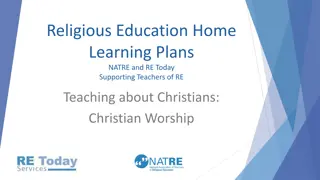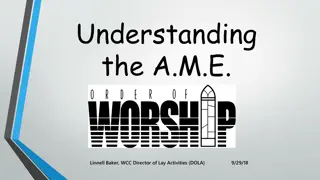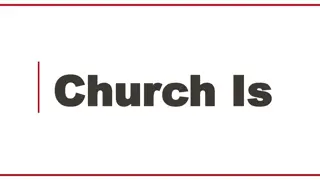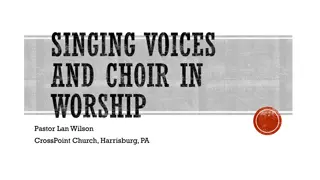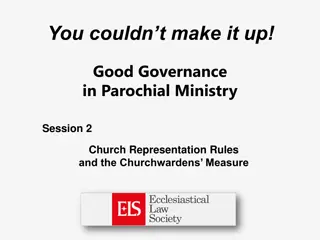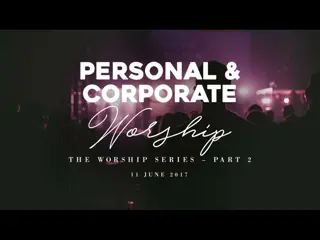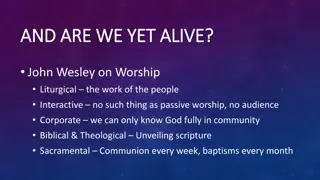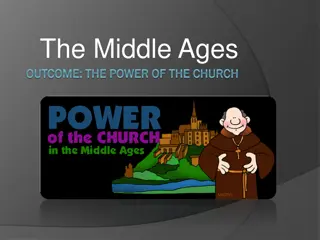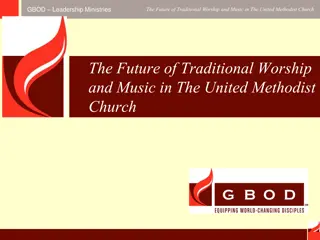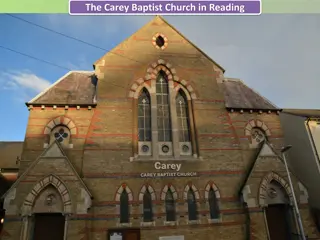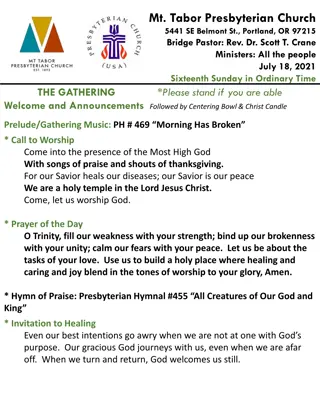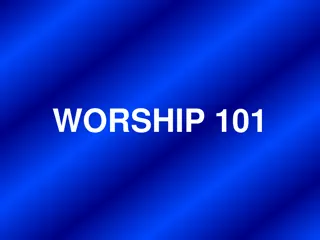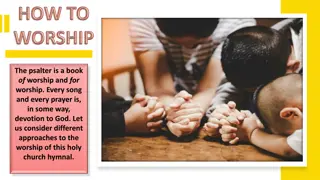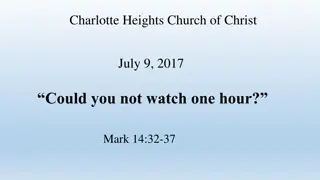Exploring Worship in My Church Community
Explore the worship practices and community engagement of My Church through a Lenten program. Discover the history and significance of worship, led by Reverend Paul C. McCabe and team members. Reflect on the nature of the church in Christ as a sacrament of unity and communion with God. Join us in understanding what worship means and how it brings us together in faith and reverence.
Download Presentation

Please find below an Image/Link to download the presentation.
The content on the website is provided AS IS for your information and personal use only. It may not be sold, licensed, or shared on other websites without obtaining consent from the author. Download presentation by click this link. If you encounter any issues during the download, it is possible that the publisher has removed the file from their server.
E N D
Presentation Transcript
Rector The Reverend Paul C. McCabe 2018 Assistant Priest The Reverend Gretchen Ratterree Priest Associate (retired) limited part time The Reverend Bruce Laird Wardens Sandi Harden Sr. Warden Youth & Stewardship Horace Higgins Jr. Warden Bldgs & Grounds Vestry Jan Samuel- Secretary Church Development Doug Sweet Parish Life Katie Dunlap Faith & Spirituality Ron Sedgley Finance & Stewardship Suzie Hart Servant Ministries Chris Renaud - Reach Carol Scheidler - Worship Laura Crookless Clerk of the Vestry
Lumen Gentium The church in Christ, is the nature of sacrament-a sign and instrument, that is, of communion with God and of unity among all human beings.
It is the body of Christ, it is called invisible because the greater part of those who constitute it are already in heaven or are yet unborn, and also because its members still on earth cannot certainly be distinguished.
My Church Worship During the Lenten program My Church this year we are going to explore in fun and thoughtful ways what My Church looks like and see how to bring others to want to be a part of Church When you talk about Worship what do you talk/think about? How do we worship with one another? What do you like about worship? What don t you like about worship?
History of Worship wor ship w rSH p/ noun: worship 1. the feeling or expression of reverence and adoration for a deity. "the worship of God" synonyms: reverence, veneration, adoration, glorification, glory, exaltation; More the acts or rites that make up a formal expression of reverence for a deity; a religious ceremony or ceremonies. "the church was opened for public worship" synonyms: service, religious rite, prayer, praise, devotion, religious observance "morning worship" adoration or devotion comparable to religious homage, shown toward a person or principle. synonyms: admiration, adulation, idolization, lionization, hero worship "he contemplated her with worship" Archaic- honor given to someone in recognition of their merit. BRITISH used in addressing or referring to an important or high-ranking person, especially a magistrate or mayor. noun: His Worship; noun: Your Worship; plural noun: Worships "we were soon joined by His Worship the Mayor" verb verb: worship; 3rd person present: worships; past tense: worshipped; past participle: worshipped; gerund or present participle: worshipping; past tense: worshiped; past participle: worshiped; gerund or present participle: worshiping 1. show reverence and adoration for (a deity); honor with religious rites. "the Maya built jungle pyramids to worship their gods" synonyms: revere, reverence, venerate, pay homage to, honor, adore, praise, pray to, glorify, exalt, extol; More
History of Church What does the Bible say about worship? Early worship defined in scriptures The notion of worship can be found in most of all the books in the Old Testament.
History of Worship After leaving Egypt, God gave the people of Israel the Law and then commanded that a tabernacle be constructed. The tribe of Levi was set aside to serve as priests for God and His people. The OT books of Exodus and Leviticus provide specific instructions about the manner in which worship and sacrifice was to occur, about what was to be sacrificed, and the reason for the offerings. While the people of Israel were clearly commanded to worship God (Deuteronomy 6:13 says, "You shall fear only the Lord your God; and you shall worship Him and swear by His name." Exodus 33:10 says, "When all the people saw the pillar of cloud standing at the entrance of the tent, all the people would arise and worship, each at the entrance of his tent."), little is given regarding the specifics of worship during that time.
History of Worship Early worship defined in scriptures: Acts 2:42-47 42 They devoted themselves to the apostles teaching and fellowship, to the breaking of bread and the prayers.43Awe came upon everyone, because many wonders and signs were being done by the apostles.44All who believed were together and had all things in common;45they would sell their possessions and goods and distribute the proceedsto all, as any had need.46Day by day, as they spent much time together in the temple, they broke bread at home and ate their food with glad and generous hearts,47praising God and having the goodwill of all the people. And day by day the Lord added to their number those who were being saved.
History of Worship Three liturgies would have been common place in the first century: the Synaxis, the Eucharist, and the Agape meal. We will look at these each individually but first, a few milestones or key points of interest are important to keep in mind:
History of Worship The Judeo-Centricity of Early Christianity For about the first 10 years of Christianity, it was almost exclusively composed of Jewish converts. The early Christians were in the habit of attending temple daily. The early Christians continued celebrating in the Synagogues alongside the Jews on the Sabbath for several years in some places. Up to nineteen years after Christ s resurrection, new converts to Christianity, generally speaking, had to convert to Judaism before becoming Christian. Namely, they were to be circumcised, to eat Kosher, and to follow the Mosaic Law. The Jerusalem Council was called to settle this controversy in 49 AD St. James, the bishop of Jerusalem, while the temple was still standing was in the habit of wearing the priestly robes, entering the temple, and offering intercessory prayer on behalf of his flock.
History of Worship The Domesticity of Worship The Jews allowed Gentiles to participate in their public liturgies at the Synagogue. Gentiles were even allowed to enter the outer courts of the temple.But there was a rigorous exclusion of Gentile participation in the sacred home liturgies (such as the Seder meal). Initially Christians had no public liturgy, only domestic liturgy and so the controversies regarding the direct inclusion of the Gentile converts into the Christian Church are easily understood within this context.
History of Worship The Destruction of the Temple In AD 70, the temple was destroyed. This was an earth shattering event for the Jews and a radical shift for the Jewish-Christians. It was a powerful sign that the Kingdom had come with power. The book of Hebrews was written in the 60s to explain to the Jewish Christians that Jesus was the true High Priest,that animal sacrifices were no longer necessary, and that Christ s sacrifice was perpetually sufficient. These facts seems obvious to us in hindsight, but they weren t obvious to the early Jewish Christians, particularly while the temple was still standing.
History of Worship Synaxis is the Greek word meaning meeting and is the organic continuity of the Saturday Synagogue worship. When the Christians were no longer allowed in the synagogues, they continued celebrating approximately the same rite with added Christian developments and themes. The original liturgies would have been held, like the synagogue service, in Hebrew, and some of the words, like amen and hallelujah, survive to this day. In the early part of the first century, it is unlikely that the Synaxis would have be recognizably different from the Synagogue service except for the setting. The Synaxis can be understood as the seed of what we now call the Liturgy of the Word.Some key differences include that, in the first century, there were no introduction rites, no penitential rite and no Gloria. These were all later developments.
History of Worship Basic Structure Greeting and Response (The Lord be with you or Peace be unto you) Lections & Psalmody (The Jews read in order of descending importance, starting with the Pentateuch. The early Christian kept the original order of the Synagogue, but as Christian Scripture became available, it was tacked on at the end. Thus the order of importance became reversed for Christians. They read in ascending order of importance) i. Old Testament Reading ii. Pslamody (or chanted Psalm) iii. New Testament Reading (sometimes included non-canonical books like 1 Clement) iv. Psalmody v. Gospel Reading Homily (Bishop delivers while seated) Dismissal of Catechumens by Deacon Intercessory Prayers of the Faithful Dismissal of the Faithful Occasionally a collection would be taken for the poor at the end. This was not the offertory.
History of Worship The Eucharist - Derived from the Seder meal, in its fullest proper setting, the Eucharist is the celebration of the new Passover. Pascha (or Easter) is the pinnacle of Christian worship. Initially, it is possible that in some or many Christian Churches, the Eucharist was celebrated but once a year at Passover. The celebration of this high feast of Christian worship expanded to Jewish feast days like Pentecost, and by no later than the end of the first century, the liturgical practice of the Church was to celebrate every Sunday as a mini-Easter. The Eucharist would have been celebrated early on Sunday morning, a working day in the Roman empire. The Eucharist was understood as the duty of the bishop and initially, we have every reason to believe that all Eucharists were celebrated by the bishop. But as the Church grew, this became impractical. By the end of the first century, this duty was being delegated to presbyters.
History of Worship Basic Structure Greeting & Response Kiss of Peace Offertory (Communicants bring their own bread & wine to the deacon who sets them on the altar) Eucharistic Prayer (The earliest Eucharistic prayer would have been simply a direct continuity of the Jewish Eucharistic (thanksgiving) prayer with added Messianic meaning. Noticeable differences in the first century Eucharistic prayer and today s include: a. no Sanctus, b. no Lord s prayer, c. no narrative) The Anaphora of Hippolytus is the oldest Eucharistic prayer we have in tact and it dates around AD 215. Fraction Communion (Received standing) Dismissal
History of Worship The Agape There was probably a time where the Agape meal was celebrated along with the Eucharist, as seems to be the case in 1 Corinthians 11. But this practice died out sometime in the first century although the Agape continued by itself for several centuries. The only specific and technical reference to the Agape in the New Testament is found in Jude. The Agape has connections with Mediterranean funeral feasts, said in honor of a deceased hero or family member, and with the Jewish chaburah meal. This was a communal meal Jews would eat on the eve of the Sabbath and all important Jewish feasts. Jesus would have had this meal many times with His disciples. The Christian Agape meal was liturgical, although less formal than the Eucharist or even the Synaxis. Only baptized Christians were allowed to participate in this meal.
History of Worship Like all early Christian liturgies, it was celebrated in the home. But unlike the Eucharist, it would not be celebrated in the atrium/tablinum area but in the dining room (triclinium). Thus, it would be celebrated by smaller numbers and in various homes throughout the Christian community.The Christians traditionally celebrated the Agape on Sunday evenings. Basic Structure Introductory Prayer (the president blesses the food) Meal (In the West, it seems that the breaking of the bread was part of the meal; in the East, it followed the meal. In the West, each person blessed their own cup which would have been consistent with the Jewish tradition at the chaburah meal as opposed to the communal cup for high feasts like the Seder meal.) Washing of Hands Lighting of the Lamp (brought in by the deacon, blessed by the bishop) Psalms/Hymns Bishop blesses the cup (kiddish or kiddush cup, not the cup of blessing which was reserved for the Eucharist only.) Bishop gives thanks for the bread and distributes
History of Worship Notice the order in contrast to the Eucharist. In the Agape meal, the cup precedes the bread. The Agape is described using the name eucharist in the Didache chapter 9. We know this because the cup precedes the bread. Later, in chapter 14, the Eucharist proper is explained. The term Eucharist means thanksgiving of course, and in the first century, it was not yet a technical reference to what we now call the Eucharist. Any prayer of thanksgiving at a meal would have been a eucharistic prayer. Summary By the end of the first century, the standard Christian liturgical observations would be as follows. On Saturday, you would attend the Synaxis. On Sunday morning you would attend the Eucharist, before dawn. You would go to work that day and then in the evening, you would attend an Agape meal at the house of a presbyter or perhaps the bishop s house.
History of Worship Timeline of Worship http://www.tiki-toki.com/timeline/entry/36349/History- of-Worship-Timeline-by-Steven- Simkins#vars!date=3778%20BC-12-14_14:41:17!
My Church Lenten Series February 28th - Program 2: What is Worship? History and different forms of worship, what is the right way to worship the Trinity? What should our worship look like? Father Paul March 7th - Session 3: Music and Prayer in Church - Why do we sing the songs we do? Why do we pray the prayers we do? How do we pray? Mother Gretchen March 14h - Session 4: Worship in the Episcopal Church Why do we worship and pray the way we do? What are the things we use and have colors for worship? Fr. Paul & Mthr Gretchen



